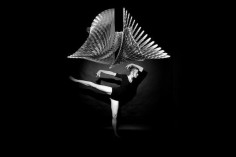CHRYSSA VARNA
Industrial Improvisation
source: chryssavarna
Architecture nowadays uses industrial robotics as a tool for fabrication. Industrial Improvisation is a project which is using them as a material for research in movement of kinetic architecture.
The project investigates how kinetic design and industrial robotics can embody the complexity of movement found in contemporary dance. Using structured improvisational techniques, a combination of pre-choreographed and improvised performances have been designed to form a gestural dialog between a dancer and two robotic performers. The result is an emerging set of movements that construct an unpredictable and evolving choreography.
Using Rudolf’s von Laban’s description of movement, the project is divided in 4 parts of movement research: body, time, space and dynamics. The human body and the way it moves is reciprocated in the movement of the robots as different parts of a dancer’s anatomy triggers differing movements. In terms of dynamics, different gestures and shapes based on McGregor ‘s improvisation process cause various qualities of the movement (e.g. A geometrical form (L-shape) and a 3d gesture (twist)). Space is in constant transformation, modulated by roboticly driven fans, puppetered by robotic armatures. As the choreography develops it creates unpredictable spatial qualities between the dancer and space.
The installation is a proposal of a stage set. The “performers” (i.e. dancer, robot arms) give and receive visual scores to and from each other. Effectively, the improvising participants (dancer and robots) continuously switch roles between choreographer and performer.
Chryssa Varna is interested in the way performance combined with technology can evolve through stage design and installation art. The project is part of an ongoing research by Chryssa Varna, on merging two parallel gradients of choreography and kinetic architecture. It draws observations about how the two disciplines can become complementary towards one another and exchange ideas. In its current state, the project focuses on prechoreographed movements which are creating a gestural vocabulary to explain and describe a set of rules based on improvisation techniques. As an ongoing project, the next step is to create actual spatial interaction by using this gestural vocabulary. Time is going to be introduced to the performance with a real time dialog between dancer and robots affecting the synchronization, and the response of the robotic performers (using the technology of body tracking with a Kinect camera and computer vision). This will be the last step towards the main question whether kinetic design and industrial robotics can embody the complexity of human movement found in a dance dialogue in contemporary dance.
The project is part of research on how a designer can achieve spatial interactivity between performers, observers, technology and a space; using the proposed vocabulary to set up a scenery for a performance or an exhibition space. Looking at the wider spectrum of architecture, this vocabulary can adapt and expand in order to choreograph and control heterogeneous materials that include movement. It might propose a further synchronisation of a repertoire of functions/movements/responses in an environment which is in conversation with its occupants. A training system in a space used by people might be choreographed by the aid of an expanded version of the bespoken vocabulary. Improvisation might offer complexity in interactivity as a form of elements that could not be found in a systematic preconceived process. This research contributes some way towards generating renewed and significant relationships between the space and its habitats.
Chryssa Varna is an architect/designer, dancer, photographer and researcher at The Bartlett School of Architecture, University College London. In 2011, she obtained her master’s degree in Architecture from the 5 years’ education in Polytechnic Faculty of Aristotle University of Thessaloniki in Greece and her professional license as an Architect Engineer. In 2013, she obtained her second master’s degree from The Bartlett School of Architecture, University College London, focusing on kinetic design and interactive technologies.
She has worked as a freelance designer/artist in collaboration with civil engineers, graphic designers, architects and artists with projects ranging from graphic design and photography to scenography installations for performances and kinetic design. She has participated in many workshops, seminars and exhibitions concerning architecture, installation design, photography and performance.
She has also studied dance and choreography in Municipal Ballet school of Larisa and participated in the Thessalian Ballet Dance Company for 4 years.
She is interested in the way performance combined with technology can evolve through stage design and installation art. Her current research focuses on designing spatial interaction by merging her two faculties as a dancer and architect, using the technology from purely mechanical automata to industrial robotics, computer vision and adaptive computation.


